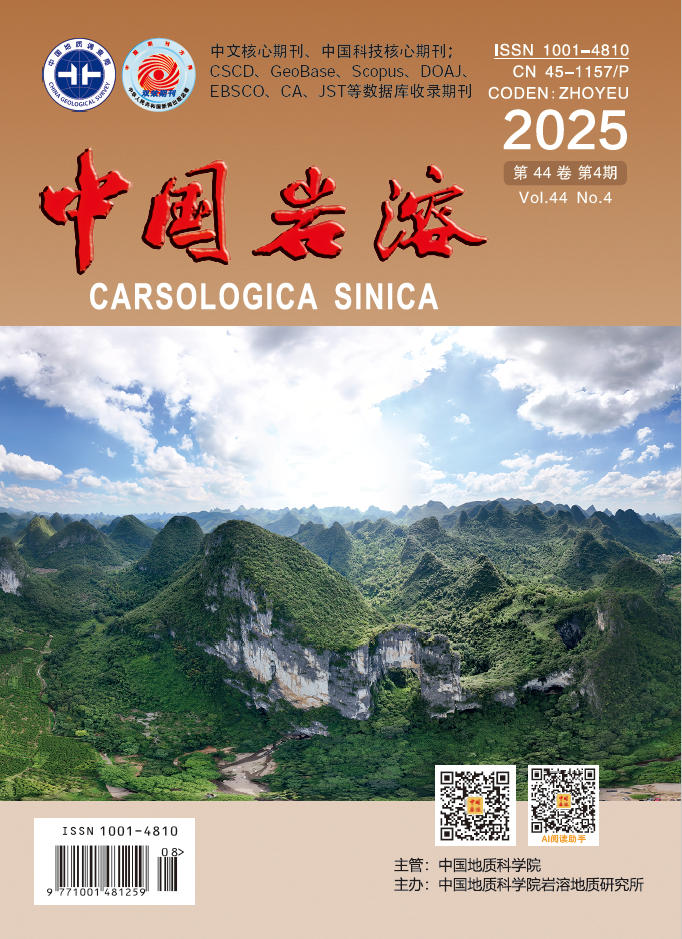, Available online , doi: 10.11932/karst2025y017
Abstract:
This study takes surface pollen samples from different land use methods/vegetation types at the Huanjiang Observation and Research Station for Karst Ecosystems, Chinese Academy of Sciences (hereinafter referred to as the Huanjiang Station) as its research object. The Huanjiang station is located in the southern part of Huanjiang Maonan Autonomous County, Hechi City, Guangxi and represents typical karst peak cluster depression ecosystem in China. It is situated in the subtropical monsoon climate zone, with a mild climate and abundant rainfall throughout the county. The forest communities are primarily composed of evergreen broadleaf forests, followed by some deciduous broadleaf and mixed evergreen coniferous and broadleaf forests.The article aims to explore the characteristics of surface pollen assemblages under different land use methods/vegetation types at the Huanjiang Station, establish a correspondence between surface pollen and modern vegetation, so as to provide theoretical references for ecological restoration, Quaternary paleoenvironmental and paleoclimate reconstruction, and historical research on human interference activities in the study area and similar karst regions.All 24 topsoil and moss samples were prepared at the Key Laboratory of Environment Change and Resources Use in Beibu Gulf (Nanning Normal University), Ministry of Education, and then standard conventional acid-base methods to extract the pollen, that is weighing about 30 g of dry samples of topsoil samples and about 3 g of dry samples of moss samples. Add HCL to dissolve calcareous minerals, HF to digest silica, and several distilled water rinses. Finally, a 7 - μm nylon sieve was used to remove unwanted small particles, then collect the pollen to a 5 ml centrifuge tube. A pill of Lycopodium spores (10,315 grains/tablet) was added to each sample to calculate pollen concentration. The percentage of each pollen taxa is based on the total terrestrial pollen sum only, whereas that of spores is based on the sum of both pollen and spores. Pollen and spores were identified using a Leica DM4000 B microscope with 200/400x magnification. More than 300 pollen grains of per sample were counted. The programs Tilia (version 1.7.16) was used to construct the pollen diagrams. Using the Canoco (versions 5.0) software, principal component analysis (PCA) was applied to the pollen percentage data.The results show, (1) A total of 49 pollen taxa (genera or family)were identified from 24 topsoil (or moss) samples in the Huanjiang Station, 25 taxa belonged to trees and shrubs, there are mainly Pinus, Cupressaceae/ Taxodiaceae, Fabaceae, Euphorbiaceae, Magnoliaceae, Moraceae, among them, Pinus had the highest content (averaging 56.8% and reaching a maximum of 87.62%). And 20 taxa were Herbaceous, there are mainly Poaceae, Asteraceae, Araceae. The spores of ferns are mainly Nephrolepis, Dicranopteris and Pteris. In addition, freshwater algae ( Concentricystis ) spores also appeared in the samples.(2)There was a large difference in the concentration of topsoil pollen among different land use methods/vegetation types in the depression of Huanjiang Station, the lowest pollen concentration was 4,131 grains · g−1 in the topsoil samples of the secondary growth of forest, and the highest was 41,6781 grains · g−1 in planted restoration forest. The average pollen concentration was relatively low, at 54,432 grains · g−1. There was a significant difference in the average concentrations of topsoil samples and moss samples, which were 27,371 grains · g−1 and 189,738 grains · g−1, respectively. Among all the samples, Pinus pollen had the highest concentration, reaching 19,232 · g−1, followed by Asteraceae ( 2,280 grains · g−1 ), Poaceae ( 1,535 grains · g−1 ) and Euphorbiaceae ( 1,461 grains · g−1 ). In addition, the spore concentration of ferns was relatively high, with an average of 6, 353 spores · g−1. (3)The result of principal component analysis ( PCA ) show that the pollen assemblage was well discrete and was heterogeneous, which could roughly achieve classification. Among different land use methods/vegetation types, corn fields correspond clearly with Zea, and coniferous woodland correspond clearly with Moraceae, enabling effective differentiation. Secondary growth of forest and planted restoration forest can be concentrated relatively well.The conclusion of this article is, (1)The topsoil pollen composition corresponds well with the vegetation types of each land use type/vegetation type and the combination of surface pollen can basically reflect the overall characteristics of vegetation around the depression. (2)PCA analysis can effectively distinguish grassland, planted restoration forest, coniferous woodland, secondary growth of forest, and cornfields, it shows that the surface pollen of different land use / vegetation types has obvious differentiation. However, mulberry forest cannot be well distinguished, which may be related to the fact that Morus sampling time and pollen preservation conditions.(3)The pollen concentrations of different land use methods/vegetation types are in the order of planted restoration forest > mulberry forests > cornfields > secondary growth of forest > grasslands > coniferous woodland, which may be closely related to vegetation composition, soil disturbance, and pollen preservation conditions.






